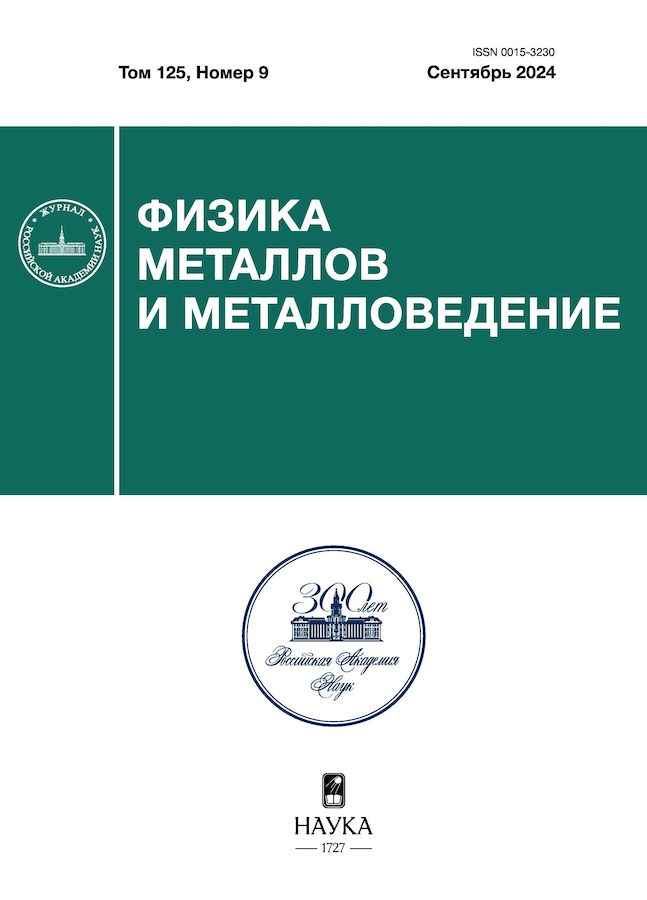Distribution of composition across the interface in binary alloys
- Authors: Gapontsev V.L.1, Gapontsev A.V.2, Gapontsev V.V.2
-
Affiliations:
- Russian State Professional and Pedagogical University
- M.N. Miheev Institute of Metal Physics of Ural Branch of Russian Academy of Sciences
- Issue: Vol 125, No 9 (2024)
- Pages: 1171-1179
- Section: СТРУКТУРА, ФАЗОВЫЕ ПРЕВРАЩЕНИЯ И ДИФФУЗИЯ
- URL: https://innoscience.ru/0015-3230/article/view/677441
- DOI: https://doi.org/10.31857/S0015323024090112
- EDN: https://elibrary.ru/KEJQXF
- ID: 677441
Cite item
Abstract
For one-dimensional case of binary substitution alloys, the parameters of the diffuse interface and the distribution of the composition within it are calculated using the thermodynamic approach. It is shown that the estimate of the equilibrium solubility limits in the quasi-regular solution model coincides with the results of the Gibbs construction and the results obtained using the Cahn–Hilliard approach. It is found that the interface width weakly depends on the chosen approximation. A strong dependence on the employed approximation is characteristic of the equilibrium solubility limits. It is also demonstrated that approaches that are different from the quasi-regular solution model lead to a violation of Maxwell’s equal area rule. It is shown that the parameters determining the shape of the distribution curve of the composition along the interface have substantially different behavior within the quasi-regular solution model and in the case of regular calculations.
Full Text
About the authors
V. L. Gapontsev
Russian State Professional and Pedagogical University
Author for correspondence.
Email: vlgap@mail.ru
Russian Federation, Ekaterinburg, 620143
A. V. Gapontsev
M.N. Miheev Institute of Metal Physics of Ural Branch of Russian Academy of Sciences
Email: vlgap@mail.ru
Russian Federation, Ekaterinburg, 620108
V. V. Gapontsev
M.N. Miheev Institute of Metal Physics of Ural Branch of Russian Academy of Sciences
Email: vlgap@mail.ru
Russian Federation, Ekaterinburg, 620108
References
- Гиббс Дж. В. Термодинамические работы / Пер. с англ. М., Л.: Гостехиздат, 1950. 492 с.
- Кристиан Дж. Теория превращений в металлах и сплавах. М.: Мир, 1978. 806 с.
- Лоренц Г.А. Лекции по термодинамике. Ижевск: НИЦ “Регулярная и хаотическая динамика”, 2001. 176 с.
- Kaufman L., Nesor H. Coupled phase diagrams and thermochemical data for transition metal binary systems. Ch. I // CALPHAD. 1978. V. 2. № 1. P. 55–80.
- Kaufman L., Nesor H. Coupled phase diagrams and thermochemical data for transition metal binary systems. Ch. II // CALPHAD. 1978. V. 2. № 1. P. 81–108.
- Kaufman L., Nesor H. Coupled phase diagrams and thermochemical data for transition metal binary systems. Ch. III // CALPHAD. 1978. V. 1, 2. № 2. P. 117–146.
- Kaufman L., Nesor H. Coupled phase diagrams and thermochemical data for transition metal binary systems. Ch. IV // CALPHAD. 1978. V. 2. № 4. P. 295–318.
- Cahn J.W., Hillard J.E. Free Energy of a Nonuniform System. I. Interfacial Free Energy // J. Chem. Phys. 1958. V. 28. № 2. P. 1121–1124.
- Cahn J.W. Free Energy of a Nonuniform System. II. Thermodynamic Basis // J. Chem. Phys. 1959. V. 30. № 5. P. 258–267.
- Cahn J.W., Hillard J.E. Free Energy of a Nonuniform System. III. Nucleation in a Two-Component Incompressible Fluid // J. Chem. Phys. 1959. V. 31. № 3. P. 688–699.
- Hart E.W. Thermodynamics of Inhomogeneous Systems // Phys. Rev. 1959. V. 113. № 2. P. 412–416.
- Разумов И.К. Спинодальный распад сплава с сильной концентрационной зависимостью коэффициента взаимной диффузии // ФТТ. 2022. T. 64. Вып. 1. C. 19–24.
- Гапонцев В.Л., Селезнев В.Д., Гапонцев А.В. Распад равновесной межфазной границы в сплавах замещения при механосплавлении // ФММ. 2017. Т. 118. № 7. С. 665–678.
- Czubayko U., Wanderka N., Naundorf V., Ivchenko V.A., Yermakov A. Ye., Uimin M.A., Wollenberg H. Characterization of nanoscaled heterogeneities in mechanically alloyed and compacted Cu–Fe // Mater. Sci. Forum. 2000. V. 343–346. P. 709–714.
- Ivchenko V.A., Uimin M.A., Yermakov A. Ye., Korobeinikov A. Yu. Atomic Structure and Magnetic Properties of Cu80Co20 Nanocrystalline Compounds Produced by Mechanical Alloying // Surf. Sci. 1999. V. 40. № 3. P. 420–428.
- Costa B.F.O., Le Caër G., Luyssaert B. Mőssbauer studies of phase separation in nanocrystalline alloys prepared by mechanical alloying // J. Alloys Compounds. 2003. V. 350. № 1. P. 36–46.
- Гапонцев В.Л., Гапонцев А.В., Кондратьев В.В. Определение положения бинодали бинарного сплава на основе гипотезы слабой нелокальности // ФММ. 2019. Т. 120. № 12. С. 1264–1270.
- Гапонцев В.Л., Гапонцев А.В., Гапонцев В.В., Кондратьев В.В. Определение параметров межфазной границы в гетерогенных бинарных сплавах на основе гипотезы слабой нелокальности // ФММ. 2021. Т. 122. № 1. С. 31–37.
- Хачатурян А.Г. Теория фазовых превращений и структура твердых растворов. М.: Наука, 1974. 384 с.
Supplementary files

















